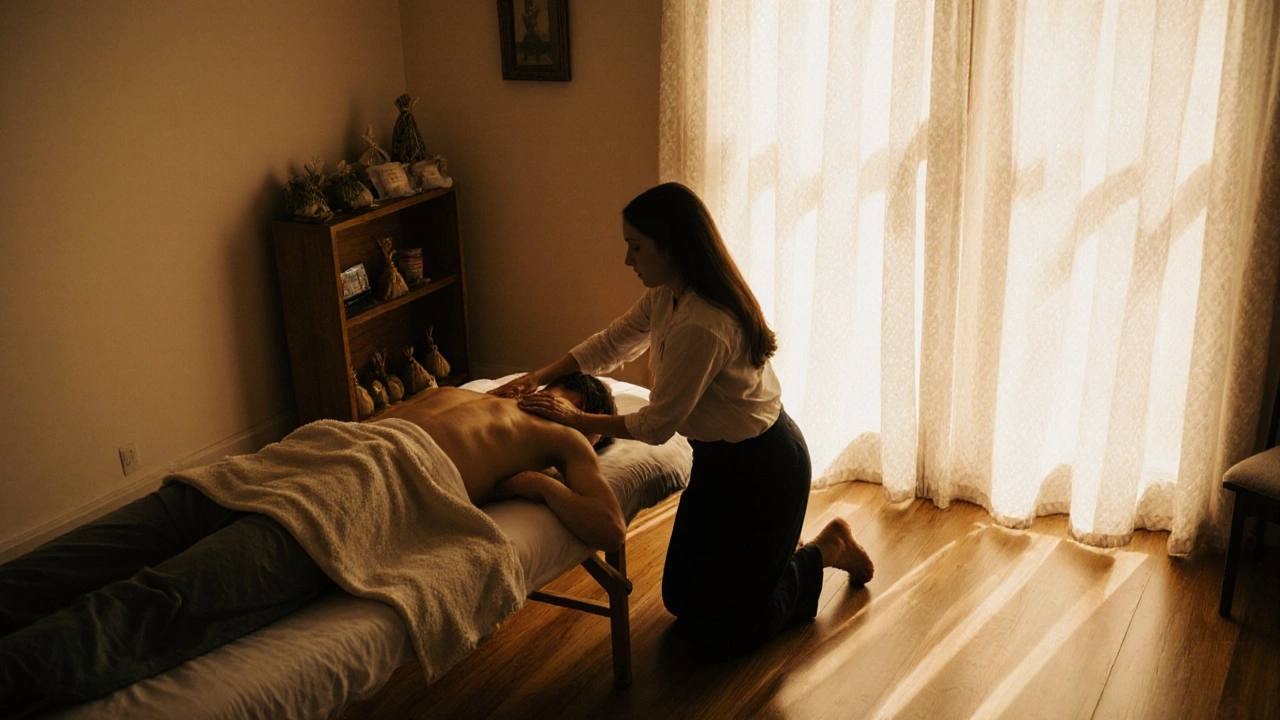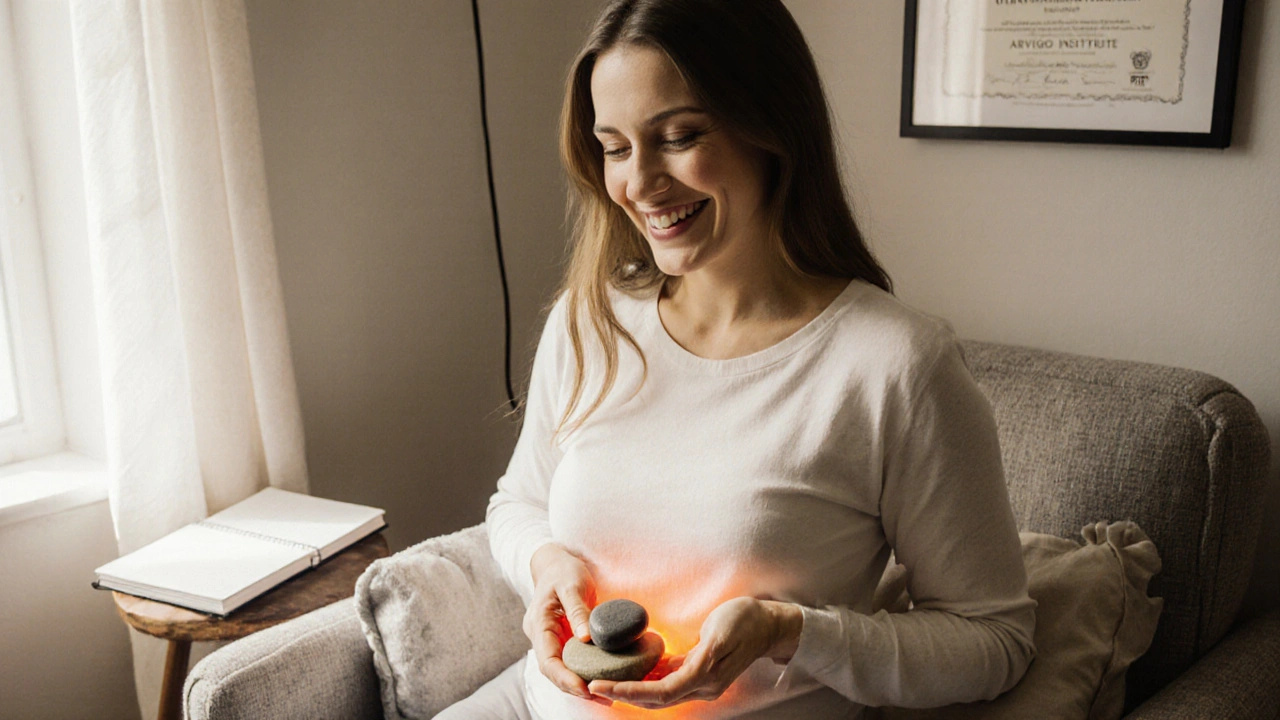Maya Abdominal Massage: A Natural Remedy for Chronic Pain
 Nov, 15 2025
Nov, 15 2025
Maya Abdominal Pain Assessment Tool
This tool helps determine if your chronic pain might be related to organ displacement. Based on the article content, Maya Abdominal Massage addresses root causes of pain through gentle repositioning of internal organs.
Your Symptoms
Check all symptoms you're currently experiencing:
Your Situation
Select relevant factors about your health history:
Assessment Results
Chronic pain doesn’t just hurt-it drains your energy, ruins your sleep, and makes everyday tasks feel impossible. If you’ve tried medications, physical therapy, or even surgery and still feel stuck, you’re not alone. Many people turn to Maya Abdominal Massage, an ancient technique rooted in Indigenous Mesoamerican healing traditions, to find relief where other methods failed.
What Is Maya Abdominal Massage?
Maya Abdominal Massage, also called Abdominal Massage or Arvigo Techniques of Maya Abdominal Therapy, is a gentle, non-invasive hands-on therapy that repositions internal organs to improve circulation, reduce tension, and restore natural function. Developed by Dr. Rosita Arvigo, it blends traditional Maya healing practices with modern anatomy and physiology.
This isn’t just about rubbing your stomach. It targets the position and movement of organs like the uterus, bladder, intestines, and ovaries. When these organs shift out of place-due to surgery, injury, poor posture, or chronic stress-they can pull on ligaments, compress nerves, and restrict blood flow. That’s where the pain starts.
Unlike deep tissue or Swedish massage, Maya Abdominal Massage uses light, sustained pressure and specific directional movements. Practitioners learn to feel how organs move under the skin and guide them back to their optimal position. Think of it like gently untangling a knot inside your body.
How It Helps With Chronic Pain
Chronic pelvic pain, lower back pain, digestive issues, and menstrual cramps often stem from organ displacement or poor circulation in the abdomen. Maya Abdominal Massage addresses these root causes.
For example, a uterus that tilts backward (retroverted) can press against the sacrum and sciatic nerve, causing persistent lower back and leg pain. A twisted or congested colon can lead to bloating, constipation, and referred pain in the hips. When organs are in their right place, pressure on nerves and blood vessels drops-and so does the pain.
One 2021 study tracking 87 women with chronic pelvic pain found that after eight weekly sessions of Maya Abdominal Massage, 78% reported a 50% or greater reduction in pain levels. Many also saw improvements in digestion, sleep, and emotional well-being.
It’s not magic. It’s mechanics. When blood flow improves, inflammation decreases. When nerves aren’t compressed, signals stop firing in pain mode. When organs can move freely, the body heals itself.
Who Benefits Most?
This therapy isn’t for everyone-but it’s especially powerful for people with:
- Chronic lower back or pelvic pain without clear medical cause
- Endometriosis, fibroids, or adenomyosis
- Post-surgical adhesions (after C-sections, hysterectomies, or appendectomies)
- Chronic constipation or IBS that doesn’t respond to diet changes
- Recurrent urinary tract infections or bladder pressure
- Menstrual cramps so severe they disrupt work or sleep
Men benefit too. Prostate congestion, chronic digestive issues, and post-hernia surgery discomfort often improve with this technique. It’s not just a "women’s therapy"-it’s a body reset for anyone with abdominal tension.
What Happens During a Session?
A typical session lasts 60 to 90 minutes. You lie on your back, fully clothed, with a warm towel placed over your abdomen. The practitioner begins by assessing your abdominal tone and organ position through light palpation.
Then comes the massage: slow, circular strokes, gentle lifting, and directional pressure to guide organs into alignment. You might feel warmth, tingling, or a soft gurgle as blood flow increases. Some people feel emotional-this work releases stored tension, not just physical.
The first session includes education. You’ll learn how to do simple self-massage at home using a warm stone or heating pad. Practitioners often teach breathing techniques and postural corrections to prevent organs from shifting again.
Most people need 4 to 8 sessions spaced weekly to see lasting change. After that, monthly maintenance helps keep things in balance.

What You Can Expect After Treatment
Right after a session, you might feel relaxed, slightly tired, or even a bit emotional. Some report a temporary increase in discomfort as toxins shift-this is normal and usually fades within 24 hours.
Within a week, many notice:
- Less bloating and gas
- Improved bowel movements
- Reduced menstrual cramps
- Lower back pain easing up
- Deeper, more restful sleep
One woman with a 12-year history of chronic pelvic pain from endometriosis said, "After three sessions, I stopped taking painkillers. I didn’t know my body could feel this light."
How It Compares to Other Therapies
Here’s how Maya Abdominal Massage stacks up against common chronic pain treatments:
| Treatment | How It Works | Time to Relief | Long-Term Results | Side Effects |
|---|---|---|---|---|
| Maya Abdominal Massage | Repositions organs, improves circulation | 1-4 weeks | High-addresses root cause | None |
| NSAIDs (Ibuprofen, etc.) | Reduces inflammation temporarily | Hours | Low-symptom masking | Stomach ulcers, kidney strain |
| Physical Therapy | Strengthens muscles, improves posture | 4-12 weeks | Moderate | Can aggravate if done incorrectly |
| Surgery | Removes tissue or repairs structure | Months | Variable-adhesions often return | Infection, scarring, recovery time |
| Acupuncture | Stimulates nerve pathways | 2-6 weeks | Moderate | Minor bruising |
Maya Abdominal Massage stands out because it doesn’t just numb pain-it fixes the underlying mechanical issue. No drugs. No cuts. Just hands, time, and a deep understanding of the body’s natural design.
Where to Find a Qualified Practitioner
Not every massage therapist knows this technique. Look for someone certified by the Arvigo Institute of Maya Abdominal Therapy. They complete 200+ hours of training and must pass a practical exam.
You can search their directory online or ask local holistic clinics, midwives, or fertility specialists for referrals. Avoid practitioners who promise "instant results" or use heavy pressure-it’s not about force, it’s about precision.
Costs range from $80 to $150 per session, depending on location and experience. Many insurance plans don’t cover it yet, but some FSA/HSA accounts do.

Can You Do It Yourself?
Yes-but only after learning the proper technique. Self-massage is a powerful tool for maintenance, but beginners should start with a professional.
Here’s a simple routine you can try at home after your first session:
- Warm a small stone or rice sock in the microwave for 30 seconds.
- Place it over your lower abdomen for 5 minutes.
- Use your fingertips to make slow, clockwise circles around your navel-this helps digestion.
- Place both hands just above your pubic bone. Gently lift upward and hold for 10 seconds. Release slowly.
- Repeat 3 times a day, especially before bed.
Never press hard. If it hurts, stop. This isn’t a workout-it’s a conversation with your body.
When to Avoid It
Maya Abdominal Massage is safe for most people-but skip it if you:
- Are pregnant (unless trained in prenatal-specific techniques)
- Have an active infection or fever
- Recently had abdominal surgery (wait at least 6-8 weeks)
- Have an IUD in place (some practitioners advise caution, though many use it safely)
- Have cancer in the pelvic region
Always talk to your doctor before starting, especially if you have a complex medical history.
Why This Works When Other Things Don’t
Modern medicine excels at treating acute injuries and infections. But chronic pain? It’s often a mystery. Doctors run tests, find nothing, and say "it’s all in your head." That’s not true. Your body is sending signals-it’s just not the kind a CT scan can catch.
Maya Abdominal Massage works because it listens to the body’s physical language. It sees pain not as a symptom to suppress, but as a clue to a misalignment. It doesn’t fight the body-it helps it remember how to function the way it was meant to.
People don’t just stop hurting. They start feeling alive again. They sleep through the night. They walk without bracing. They laugh without flinching.
If you’ve been told there’s nothing more to do, maybe it’s not that there’s no solution. Maybe you just haven’t found the right key yet.
Is Maya Abdominal Massage the same as a regular belly massage?
No. Regular belly massage focuses on relaxation or digestion using broad strokes. Maya Abdominal Massage is precise-it targets the position of internal organs using specific directional pressure based on anatomy. It’s therapeutic, not just soothing.
How soon can I expect results?
Some feel relief after one session, especially with bloating or mild cramping. For chronic pain, most people see clear improvement after 4 to 6 weekly sessions. Lasting change takes time because organs have been in the wrong place for months or years.
Can this help with infertility?
Many women seeking fertility support use Maya Abdominal Massage to improve blood flow to the reproductive organs and reduce adhesions that may block fallopian tubes. It’s not a guaranteed fix, but studies show improved cycle regularity and reduced pelvic congestion in women with unexplained infertility.
Is it safe after a C-section?
Yes, but only after 6-8 weeks of healing. Scar tissue can pull organs out of alignment, and this therapy helps release those restrictions. Many women report reduced pain, better digestion, and less back pain after combining massage with gentle stretching.
Do I need to believe in it for it to work?
No. This isn’t energy work or faith-based healing. It’s physical manipulation of anatomy. People skeptical at first often become the biggest believers once they feel the difference in their body.
If you’ve lived with chronic pain for years, it’s easy to feel hopeless. But your body hasn’t given up. It’s still trying to heal. Sometimes, all it needs is someone to gently remind it how to move.
